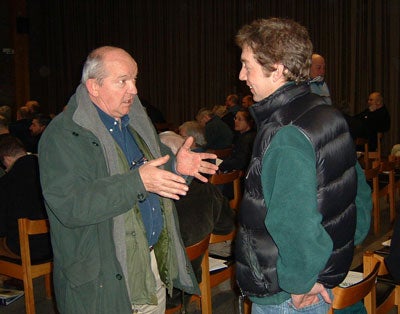| Saturday 26th February – Oxford Brookes University This was the fourth such annual event to take place and was this year attended by over 120 active members of Thames region clubs and associations. The programme for the day is a series of talks both serious and humorous and is a chance for the leading organisations to get a feeling about how the ordinary angler thinks. It is also a chance for the clubs to learn from the many qualified speakers present. After a brief opening address from Fred French of NAFAC the first speaker was John Essex who took the gathering through the many ‘new’ inventions in angling and showed how they were, in fact, old inventions that had been modernised. Items such as feeders, springtips, sliding floats (often credited to Billy Lane), and even closed face reels (pre Abu) had been developed years before they became well known. The word ‘Cormorant’ seemed very popular on angling products throughout history.
Paul Butt, Senior Wildlife Management Advisor, then took the meeting through the information required to apply for a licence to shoot cormorants and explained why this was necessary. No matter how some clubs feel they have to proof their fishery against predation first before a licence is granted, this isn’t necessarily the case nor is it practical in many cases. He also explained that the time between applying and being granted a licence in the simplest and most straightforward case had been drastically cut and could be as little as four weeks. There was then a riveting talk given by Simon Scott of Sparsholt ( www.sparsholt.ac.uk) College in Hampshire on baits bans, were they ‘Sensible Science or Silly Superstitions’? He said given that most anglers use a variety of baits (cereal, boilie and pellets) on most non-intensive fishing waters there was absolutely no problems with most baits available including peanuts and tiger nuts. Care should be exercised in the storage of all baits however, particularly those that are little used. He concluded his talk with one specific warning about the use of trout/halibut pellets in that they should not be used beyond the ‘use by’ date given on a sack or after 6 months if the commercial bag had no manufactured date on it as the oils do go off. Just before the lunch break, NAFAC held their AGM chaired by Terry Mansbridge and then it was off to the refractory for the food. After lunch there was a good humoured debate as to what fisheries and angling would be like in the year 2025. John Ellis (TFCC) took the dismal but humorous view that by then it would be all but finished with a licence costing £ 480 and less than 100,000 anglers left. “But not to worry” he concluded “as the Anti-Angling Bill will go through Parliament in two years time anyway.” Chris Poupard (Thames Region FERAC Chairman) did try to counter this with sound arguments, but the humour of John’s compelling proposal proved too great. It did lead to some sensible additional comments from the floor and this was what John really intended. Another interesting and thought provoking delivery was made by Dr Cyril Bennett on the declining fly life within rivers. This is not just of concern to trout anglers, but all anglers since coarse fish eat the larvae of many flies. His studies on the River Wey in particular showed how there were peaks and troughs and where no samples had been taken at one period is precisely where there had been a pollution incident. The last presentation of the day was given by some staff members of the Environment Agency into the impact that crayfish have on the flora and fauna in our fisheries. No-one doubted their presentation, but their argument never really convinced the gathering when asked afterwards the direct question “You have known for the past 10 years now that crayfish are a major threat to our fisheries, why haven’t you done more about it?” There was no cohesive answer and the meeting felt let down by the fact that anglers can do nothing themselves against the threat of crayfish even if they had the resources available to do something. One delegate said that they had netted and killed 41/2 tonnes of crayfish from a one-thousand metre stretch and soon after small chub and perch returned. With that an enjoyable and most enlightening day was brought to a close. Looking forward to next year’s now. |
Welcome!Log into your account











